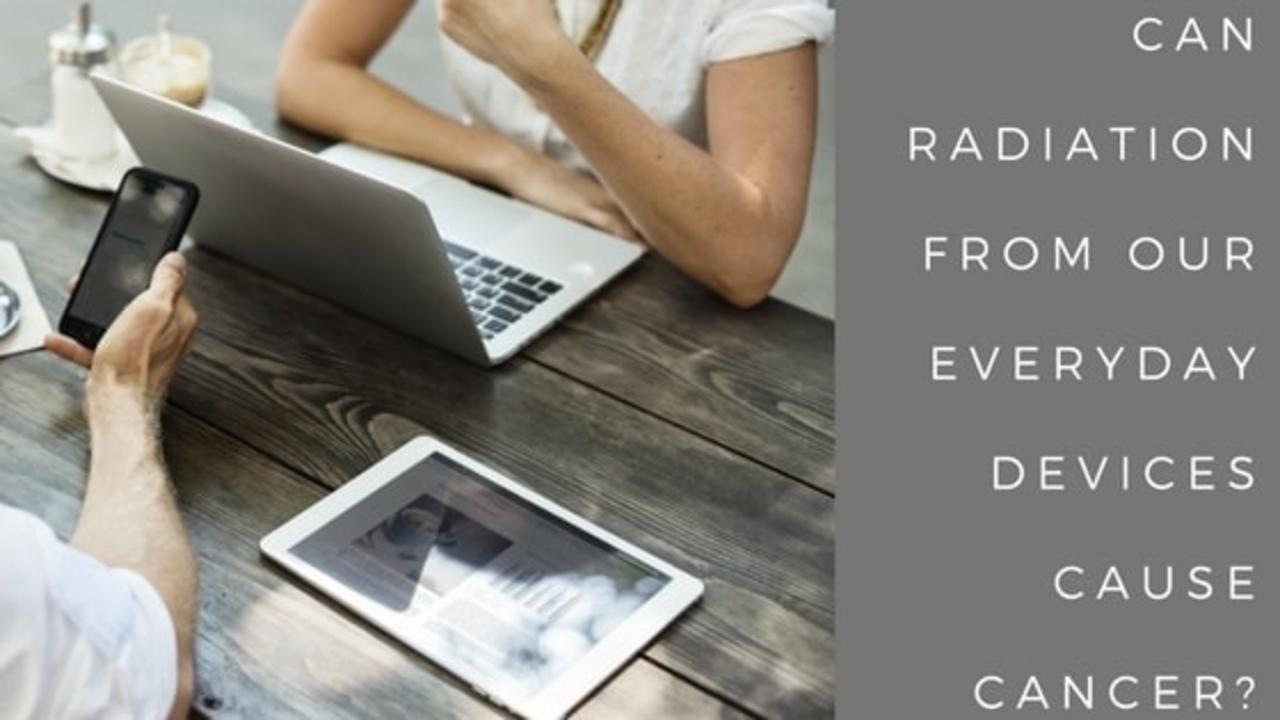
EMF and Cancer: Does Extremely Low Frequency Radiation Cause Cancer?
Nov 01, 2017In the past 30 years, there has been more concern and study on whether our daily exposures to extremely low-frequency magnetic fields (ELF) might cause cancer. One chronic source of ELF radiation is your cell phone.
This article will review the basics of radiation, what we know about radiation and cancer, and how to minimize your exposures.
What is Extremely Low Frequency (ELF) Radiation?
First, radiation is the emission, or release, of energy from any source, such as:
- X-rays
- light from the sun
- heat from our bodies
There are different types of radiation that exist across a spectrum, sometimes referred to as the electromagnetic spectrum. As can be seen in the image below, the electromagnetic spectrum ranges from very high-energy (also referred to as high-frequency) radiation to very low-energy (or low-frequency) radiation.

Image: Niehs.nih.gov
All radiation on the electromagnetic spectrum is produced by the interactions of two forces, referred to as an electric field and a magnetic field.
Electric Fields are the forces acting on charged particles (parts of atoms), like electrons or protons, which cause them to move, producing a flow of electrons-called an electric current.
Magnetic Fields are created when charged particles are in motion. The strength can be expressed in different units:
- Tesla (T)
- Microtesla (µT or one millionth of a tesla)
- Gauss (G), ( 1G equals 100 µT)

High-Energy Radiation
As you can see in the image above, high-energy radiation includes gamma rays, x-rays, and higher energy ultraviolet (UV) rays, and is classified as ionizing radiation. High-energy radiation has enough energy to remove an electron from an atom (also referred to as ionization) and damage the DNA inside cells, which can lead to mutations and uncontrolled cell growth that can lead to cancer.
Low-Energy Radiation
Low-energy radiation, which includes extremely low frequency (ELF) radiation, is a type of non-ionizing radiation. Low-energy radiation has enough energy to move atoms around or make them vibrate. Most people, including scientists, believe that non-ionizing radiation (the type that cell phones emit) cannot directly damage DNA because the power is so weak.
However, according to Dr. Devra Davis in the video below, it can. The pulsed nature of the signal is what makes it threatening to our biology. One theory why this form of radiation is risky is because it interferes with calcium efflux, which is essential to any living system. The few scientists who understand its "exquisite ability to affect cells at the level of the divalent calcium ion," according to Dr. Davis, are also concerned about the potential health threats from ELF radiation, including that from cell phones.
ELFs have even lower energy than other types of non-ionizing radiation such as radio frequency radiation, visible light, and infrared. With most types of radiation, the electric and magnetic fields are coupled and are considered together as an electromagnetic field (EMF). But with ELF radiation, the magnetic field and the electrical field can exist and act independently.
How Are People Exposed to ELF Radiation?
People are mostly exposed to ELF radiation through the use of electricity. Devices using electricity can generate ELF radiation and those devices can be anything from a washing machine to a television set. See more devices in this article: EMF Danger Levels of Home Appliances
The level of electromagnetic radiation you are exposed to depends on the strength of the electromagnetic field, your distance from the source of the field, and the length of time you are exposed. The highest levels of exposure occur when you are close to a source of a strong field, and have prolonged exposures.
Does ELF Radiation Cause Cancer?
Some believe we have enough evidence to prove that it increases the likelihood of developing cancers. Others stick to the position that "there's no proof," implying it's safe until proven otherwise. Below are highlights to help you understand how science generally could approach the study of carcinogens.
Lab studies on carcinogens
Lab studies are a good way to find out if an exposure might possibly cause cancer. These studies include experiments on animals to see if this exposure causes tumors or other health problems. During the studies, animals are exposed to different levels of the substance, sometimes at extremely high levels.
Other lab studies expose normal human cells in a lab dish to see if this causes the types of changes that are seen in cancer cells.
Studies in people have also been carried out. These look at cancer rates in different groups of people. Comparisons of cancer rates are made between an exposed group with lower exposures to a group not exposed at all. The exposed group’s cancer rate can then be compared to the cancer rate in the general population, but the result is not always clear.
Studying ELF radiation on people
Studying the effects of ELF radiation in people can be hard. Exposure to ELF radiation is very common and it’s not possible to compare people who are exposed, to people who aren’t. Studies try to compare people exposed at higher levels to people exposed at lower levels but it is very hard to determine how much ELF radiation a person has been exposed to, especially over a long period.
The effects of ELF radiation may add up over time and no test shows that we can measure how much exposure a person has had.
To get a snapshot of an individual's ELF exposures, that person could wear a device to record their exposure levels over hours or days. EMF readings in a person’s home or workplace could be carried out and then exposure estimations could be made based on the wiring configuration of someone’s workplace/home and its distance from power lines.
These types of studies have a lot of uncertainty and can produce biased estimates of total exposure. There are no good ways to accurately estimate someone’s long-term exposure, and this is unfortunate, as this matters the most when looking for possible links to EMF and cancer risks.
Flaws with historical studies
“The standard of evidence for judging the scientific evidence should be based on good public health principles rather than demanding scientific certainty before actions are taken.”
-- Bioinitiative Report
The possible link between EMF and cancer has been a subject of controversy for decades. The developing science highlights that we have not necessarily been pursuing the most relevant questions when examining how electromagnetic fields may impact our health.
1. Not enough data. Since cancer can take decades to develop, and the iPhone was released just 10 years ago in 2007, we haven't had enough time and data to assess cancer risks in humans. In the past, cell phone studies examined cancer development over a period of less than 10 years. More recent studies are finding a stronger link between cell phone radiation and cancer because the duration of study is often longer. Any long term study of EMFs affect on human cells did not have enough time to come to an accurate conclusion.
Take a look at this article for more information: Major Cell Phone Radiation Study Reignites Cancer Questions
2. Investigating the right questions. The Bioinitiative Reports include two—one released in 2007 and the second in 2012—that were created by 29 scientists from ten different countries. Their intention was to focus on studies covering more long term effects on the human body caused by EMF exposure.
Two key concerns were:
1) Non-thermal effects. Most federally funded EMF safety studies focused on the heating effects of devices like laptops and cellphones in contact with the body, which, in the short term, showed little detriment. Modern science recognizes that further study is needed on the non-thermal effects.
"New standards should be developed based on knowledge of mechanisms of non-thermal effects. Importantly, because the signals of mobile communication are completely replaced by other signals faster than once per 10 years, duration comparable with latent period, epidemiologic studies cannot provide basement for cancer risk assessment from upcoming new signals."
3. Unique vulnerabilities. The Bioinitiative also stressed an urgency to considering the heightened potential effects EMF exposure could have on children.
Since then, one major federal study, performed by the National Toxicology Program, released some alarming connections between rats in utero exposed to a lifetime's worth of EMF radiation and certain kinds of brain and heart cancer.
Opinions by expert agencies
Opinions by expert agencies vary, which further challenge the public's ability to understand what a reasonable level of concern should be. To date, cancer has been the main focus.
The International Agency for Research on Cancer (IARC) is part of the World Health Organization (WHO) and their goal is to identify causes of cancer. They considered the evidence for ELF magnetic and electric fields separately (in 2002) and found “inadequate evidence” for the carcinogenicity of ELF magnetic fields based on studies in lab animals and “inadequate evidence” for the carcinogenicity of ELF electric fields in humans.
They also classified ELF magnetic fields as “possibly carcinogenic to humans” and ELF electric fields as “not classifiable as to their carcinogenicity to humans”.
The US National Institute of Environmental Health Sciences (NIEHS) described the scientific evidence of ELF exposure to pose a health risk as “weak” but cannot be recognized as entirely safe because it is a “possible” human carcinogen.
The American Academy of Pediatrics warns that children deserve extra protection. In a letter to Congressman Dennis Kucinich dated 12 December 2012, it wrote:
"Children are disproportionately affected by environmental exposures, including cell phone radiation. The differences in bone density and the amount of fluid in a child’s brain compared to an adult’s brain could allow children to absorb greater quantities of RF energy deeper into their brains than adults. It is essential that any new standards for cell phones or other wireless devices be based on protecting the youngest and most vulnerable populations to ensure they are safeguarded through their lifetimes."
Other potential health risks
There has been broadening study of how ELF radiation may harm us. Another area of research is our reproductive health, including fertility.
How Can I Avoid Exposure to ELF Radiation?
The NIEHS recommendation for people concerned about their exposure to EMF (and ELF radiation) is to find out where the major EMF sources are, move away from these devices and limit the time spent near them.
Here you can find more information about EMFs:
- WiFi EMF: What is it & How Do You Protect Yourself?
- What are EMFs? Your Guide to The Types & Sources
Detox Your EMFs
When you feel ready to detox your habits and home of EMFs, then consider our 21 Day Digital Detox to learn how to manage technology and decrease your exposure to EMFs, ELF, and other potentially harmful sources.


